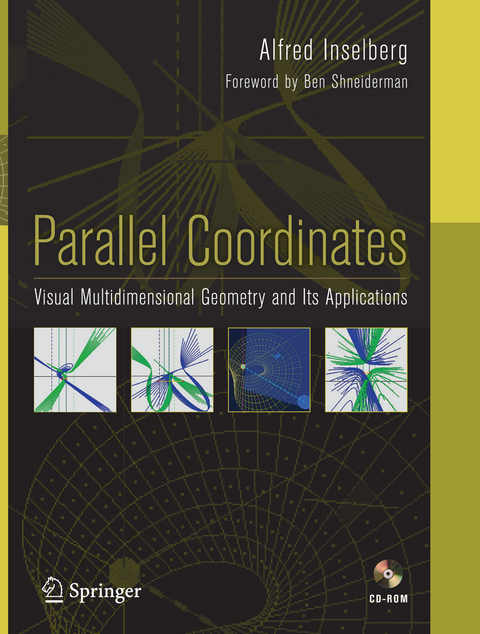
Parallel Coordinates
Visual Multidimensional Geometry and Its Applications
Seiten
2017
|
Softcover reprint of the original 1st ed. 2009
Springer-Verlag New York Inc.
978-1-4939-5032-4 (ISBN)
Springer-Verlag New York Inc.
978-1-4939-5032-4 (ISBN)
The breakthrough idea of parallel coordinates has enchanted many people with its cleverness and power. Just as Cartesian coordinates help us understand 2D and 3D geometry, parallel coordinates offer fresh ways of thinking about and proving theorems in higher-dimensional geometries.
The breakthrough idea of parallel coordinates has enchanted many people with its cleverness and power. Al Inselberg, the source of that cleverness and power, ?nally shares the depth and breadth of his invention in this historically important book. I’ve been waiting impatiently for this exposition since I was captivated by Inselberg’slectureattheUniversityofMarylandin1979.Hehadalreadyunderstood the potential parallel coordinates has for generating insights into high-dimensional analysis and information visualization. In the following decades he polished the arguments, built effective software, and demonstrated value in important appli- tions. Nowabroadcommunityofreaderscanbene?tfromhisinsightsandeffective presentation. I believe that Inselberg’s parallel coordinates is a transformational ideal that ´ matches the importance of Rene Descartes’ (1596–1650) invention of Cartesian coordinates. Just as Cartesian coordinates help us understand 2D and 3D geometry, parallel coordinates offer fresh ways of thinking about and proving theorems in higher-dimensional geometries. At the same time they will lead to more powerful tools for solving practical problems in a wide variety of applications. It is rare to encounter such a mind-shattering idea with such historic importance. While Inselberg’s insight and exposition opens the door to many discoveries, there is much work to be done for generations of mathematicians, computer sci- tists, programmers, and domain experts who will need to build on these innovative ideas.
The breakthrough idea of parallel coordinates has enchanted many people with its cleverness and power. Al Inselberg, the source of that cleverness and power, ?nally shares the depth and breadth of his invention in this historically important book. I’ve been waiting impatiently for this exposition since I was captivated by Inselberg’slectureattheUniversityofMarylandin1979.Hehadalreadyunderstood the potential parallel coordinates has for generating insights into high-dimensional analysis and information visualization. In the following decades he polished the arguments, built effective software, and demonstrated value in important appli- tions. Nowabroadcommunityofreaderscanbene?tfromhisinsightsandeffective presentation. I believe that Inselberg’s parallel coordinates is a transformational ideal that ´ matches the importance of Rene Descartes’ (1596–1650) invention of Cartesian coordinates. Just as Cartesian coordinates help us understand 2D and 3D geometry, parallel coordinates offer fresh ways of thinking about and proving theorems in higher-dimensional geometries. At the same time they will lead to more powerful tools for solving practical problems in a wide variety of applications. It is rare to encounter such a mind-shattering idea with such historic importance. While Inselberg’s insight and exposition opens the door to many discoveries, there is much work to be done for generations of mathematicians, computer sci- tists, programmers, and domain experts who will need to build on these innovative ideas.
Geometry Background.- ? FT-1 The Plane with Parallel Coordinates.- Multidimensional Lines.- Planes, p-Flats, and Hyperplanes.- ** Envelopes.- Curves.- Proximity of Lines, Planes, and Flats.- Hypersurfaces in ?N.- ? FT Data Mining and Other Applications.- Recent Results.- Solutions to Selected Exercises.
| Erscheinungsdatum | 23.03.2017 |
|---|---|
| Zusatzinfo | XXVI, 554 p. |
| Verlagsort | New York |
| Sprache | englisch |
| Maße | 178 x 235 mm |
| Themenwelt | Informatik ► Datenbanken ► Data Warehouse / Data Mining |
| Informatik ► Grafik / Design ► Digitale Bildverarbeitung | |
| Informatik ► Software Entwicklung ► User Interfaces (HCI) | |
| Mathematik / Informatik ► Mathematik ► Algebra | |
| Mathematik / Informatik ► Mathematik ► Geometrie / Topologie | |
| Mathematik / Informatik ► Mathematik ► Graphentheorie | |
| Mathematik / Informatik ► Mathematik ► Wahrscheinlichkeit / Kombinatorik | |
| Naturwissenschaften | |
| Schlagworte | Algebra • Cognition • computer vision • Data Mining • Information Visualization • linear algebra • Visualization |
| ISBN-10 | 1-4939-5032-0 / 1493950320 |
| ISBN-13 | 978-1-4939-5032-4 / 9781493950324 |
| Zustand | Neuware |
| Haben Sie eine Frage zum Produkt? |
Mehr entdecken
aus dem Bereich
aus dem Bereich
Datenanalyse für Künstliche Intelligenz
Buch | Softcover (2024)
De Gruyter Oldenbourg (Verlag)
CHF 104,90
Daten importieren, bereinigen, umformen und visualisieren
Buch | Softcover (2024)
O'Reilly (Verlag)
CHF 76,85


